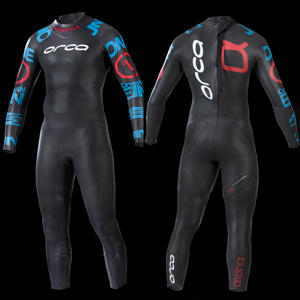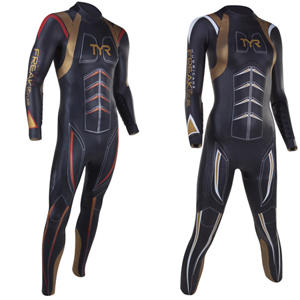
This is a new brand fronted by Dean Jackson, ex of blueseventy and Quintana Roo. Huub is named after Huub Toussaint, a PhD in biomechanics who specializes in the science of swimming.
The theme of this company is to tailor a wetsuit to match a swimmer's specific strengths and weaknesses or, more precisely, to match a swimmer's aspect in the water.
The idea is this: if you're a good swimmer, your legs don't sink, and you don't need to float them. If you're a bad swimmer, they do, and you do. There are two versions of every HUUB model: the 3:5 and the 4:4. The former consists of 3mm rubber in the chest, and 5mm in the hips and legs. The 4:4 is just that thickness of rubber throughout.
I swam in the Archimedes 3:5. On paper, this is either the right or wrong suit for me depending on whether I make the cut as a technically good swimmer, or am congenitally mired in my shit technique ignominy.
I can see that argued either way, depending on whom is the arbiter of my swim style.
For this test, I wore a 3:5, and it is a thematic match for what I used as a control suit: an Orca Alpha. Each suit is constructed around the idea that you need to float the legs at the expense of the rest of the body.
I'd like a chance to ask Dr. Toussaint how he feels about this. When I had our QR suits tested a the flume in Colorado Springs—in a former millenium—what we got back was interesting. There were a certain few swimmers who got faster and faster as the rubber below the waist was reduced. There was no analysis of this by those at the flume. It was resident and national team members doing the swimming, and it occurred to me at the time that swimmers with a more demonstrable kick would have some trouble getting all that 5mm rubber into down the water.

Hence the 4:4 suit, which adds rubber to the chest and takes it out of the legs. However, why not 5:5? Or even 5:3? I don't know. And, it's not relevant to this review, which is of the 3:5 Archimedes.
This suit also features a core stabilizer, and a lot of suits are doing this nowawadays. Aquasphere, TYR and others basically place you in a sort of girdle, and don't allow you to engage in the bad habits that you otherwise might, such as jackknifing at the waist when you breathe. The "X-O Skeleton" and the "Arm Crossover alignment" are those corseting elements in the Archimedes.
The Archimedes also features a par of muscular "releases"—specifically in the bicep and calf—that portend to allow these muscles to flex and relax without constraint. Those are the red areas in the images, and are fabric only.
How much of all this stuff works? Hard to say. I didn't feel the corseting mechanics as much in this suit as I do in the others named above that employ this technique. And, I didn't feel the bicep and calf releases. However, maybe it's like that bank advertisement, when you know that your bank is operating properly when you don't notice it and never think about it.
Here are the results of this suit in the water. I followed my typical protocol, which is, four sets of 4 x 100 SCY, repeating on the 1:30 base.
2012 Orca Alpha
1:11
1:12
1:13
1:12
2012 Orca Alpha
1:12
1:12
1:12
1:12
2012 HUUB Archimedes 3.5
1:12
1:12
1:12
1:12
2012 HUUB Archimedes 3.5
1:12
1:12
1:12
1:12
These two suits swim almost identically for me, and that is to be expected since they follow very similar construction motifs. I found the HUUB to be a little longer or taller in its sizing, matching the sizing trends of QR, TYR, 2XU and Aquaman.

The construction of the suit is first rate, and I really like the way the neck closure operates. As to the front of the neck, it works fine, but, I like a little more there there, and the more substantial neck constructions of, say, Aquaman, or 2XU, are more to my liking. That said, I had no trouble with water entry in the neck, and the suit is perfectly comfortable.
One more thing about this suit. We all are familiar with the term neoprene, and this refers to a specific application of blown rubber that reaches back 80 years or so. It is a DuPont developed product, a polymerization of chloroprene. We're talking about a synthetic rubber that organizes itself into a matrix, and is a flexible construct of an elastic, synthetic rubber and air inside cells. One offshoot application is to control the kind of air that sits in those cells. Certain inert gases resist compression at depth, and when that gas is what sits inside those cells the rubber resists compression at depth. Hence the use in suits for deep sea diving.
Nevertheless, this inert gas blown smoothskin rubber is what our very first QR suits were made out of back in 1986 and 1987.
Another kind of rubber is nitrile butadiene rubber (NBR). As was the case with neoprene back in the 1930s and thereafter, it is used in automotive and industrial hoses, seals, sleeves and so forth.
HUUB has tested NBR and finds that it has less specific gravity than neoprene, so, its suits have some NBR in their construction. I have not yet uncovered any noticeable change in the performance of a wetsuit with NBR as part of its construction. However, it's too early to tell.
On thing: NBR is combustible when combined with red fuming nitric acid. So, if you contemplate swimming in a vat of red fuming nitric acid, eschew this particular wetsuit.
The HUUB Archimedes is a $700 wetsuit, which is pretty much what top end wetsuits are going for these days. It's new, and known more in Europe at the present, so, you might have to hunt around a bit for a retailer here in the U.S. But it's obtainable in North America. Still, because this company is based in the UK this might be just the sort of product you ought buy from one of those huge UK etailers.


